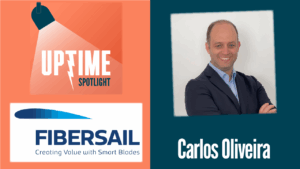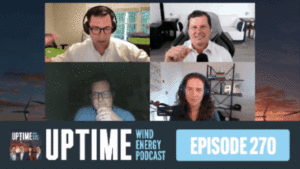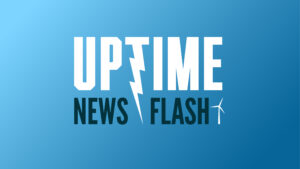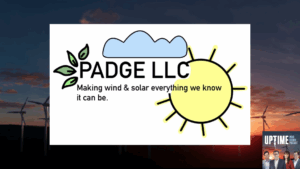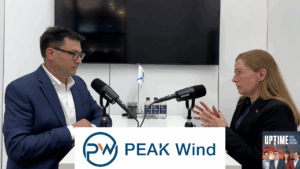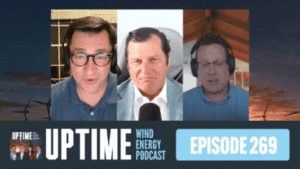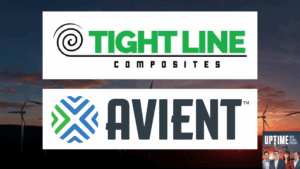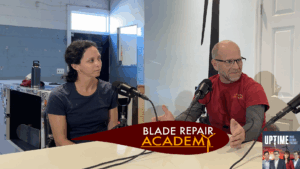We are only beginning to understand the dynamics of airflow through large wind farms. Greg Poulos, CEO and Principal Atmospheric Scientist with ArcVera, talks with Allen and Joel at ACP 2023 about the complex nature of the winds at offshore and onshore wind sites. Billions in revenue are at stake!
ArcVera Renewables – https://arcvera.com
Pardalote Consulting at https://www.pardaloteconsulting.com
Wind Power Lab – https://windpowerlab.com
Weather Guard Lightning Tech – www.weatherguardwind.com
Intelstor – https://www.intelstor.com
Podcast: Play in new window | Download
Sign up now for Uptime Tech News, our weekly email update on all things wind technology. This episode is sponsored by Weather Guard Lightning Tech. Learn more about Weather Guard’s StrikeTape Wind Turbine LPS retrofit. Follow the show on Facebook, YouTube, Twitter, Linkedin and visit Weather Guard on the web. And subscribe to Rosemary Barnes’ YouTube channel here. Have a question we can answer on the show? Email us!
ArcVera Interview
Allen Hall: Well, welcome back to the Uptime Wind Energy Podcast. We’re here at American Clean Power 2023 in New Orleans, Louisiana, and we have a couple of special guests this week. But right now we have Greg Poulos from ArcVera, and Greg is the CEO and principal atmospheric scientist with ArcVera, which is based in Colorado.
Greg, welcome to the program and the. Thank you. We really wanted to have you on because, because we had Jessica on about a year ago. Mm-hmm. In San Antonio. Yep. At ACP in 2022. The data and the information and the analysis Arc Vera does is outstanding. You stand apart from a lot of the other atmospheric companies and because you’re doing predictive aerodynamic assessments of wind farms and the, the one that was big last year was the Bight.
At the New York Bight on the leases and what kind of power production you were going to see out of those wind sites. Because the prediction was one thing from the operators, potentially, I think the Equinor Orsteds of the world, and what you were coming up with is like, well, maybe not as good as, as we have wanted it to be.
Maybe a deeper dive here. Yeah. And mostly be due to wakes and interference and the way that the, the winds are pushing. So the. The auction areas are not optimized for wind. Right. So you wanna describe some of the process you, you have gone through and, and what information you’ve found about the winds, particularly in the bite area.
What’s new there? What are, what are the winds really gonna be in the bite when they all, all these wind turbines are installed out in,
Greg Poulos: in the waters? Yeah. Yeah. So, The study we presented last year was more preliminary than what we’re presenting this year, where we looked at the long term effects on energy production.
Mm-hmm. Right. From the three lease areas of key importance that were auctioned in the, the last Boeing auction, 4.2 billion was spent. Big money. Yeah. Yeah. You know, leasing those. And so we wanted to look at the potential lost revenue associated with the misorientation of. Of those three lease areas, we call this the Misorientation penalty.
Right. Yeah. So if they had instead oriented those lease areas north, south, they wouldn’t interfere with each other as much. They picked southwest to northeast and the wind happens to blow from southwest to northeast. Yeah. And so the Southwestern most lease area wakes the next one. And those two together wake the third one, which is most heavily affected.
And in this year’s version of, of taking that study further, we found that’s between a half billion in loss revenue, conservatively calculated for the, the two that are in the Northeastern most This is unexpected, but it comes from this new technique that we validated called Windfarm Parameterization modeling.
Okay. It’s an extension of what’s called mesoscale modeling, which is a numerical weather prediction method that we u have used for decade. I’ve been doing since my degrees back in the nineties. So very familiar old technology, well proven, but now validated for wind energy applications, and so we’re just doing the tech transfer.
Joel Saxum: Okay. Oh, that makes a lot of sense. So the, so the people who bought or, or have the leasing rights to the southwest corner of the, that bite auction, they’re good.
Greg Poulos: They’re in good shape. They’re in good, they’re in better shape than the rest. I think that’s in Banerjee and edf. Ah, yes. And then kudos, the next two to the northeast might be interested in these results because they probably ran a financial model that didn’t include such severe effects.
Right. And
Allen Hall: I, I saw a webinar that I think you were in a few months ago. Yep. Where there are certain times of year based on the wind direction specifically where the power production really drops. It, it has to do sort of with the seasonal
Greg Poulos: aspect. Exactly.
Allen Hall: But it was dramatic. It wasn’t like a percent or two.
You want to talk to that?
Greg Poulos: Sure. So power prices and electricity demand peak in the summer when air conditioning’s on and it’s hazy hot and humid in 95 degrees. Right, right. Especially on the East coast. On the east coast. And it turns out the wind is predominantly from the southwest along those three Europe by lease areas.
So the, the effect is amplified for that reason, but it’s also amplified for another more subtle reason that people aren’t necessarily gonna intuitively understand. And that is, When warm air blows off the coast over the cooler waters of the Gulf Stream out there, that creates a stable, atmospheric condition.
That means hot over cold, cold ocean, hot above. That’s a stable condition, and what that means is it’s those wakes are worse. So by arranging these three lease areas the way they did, they happen to pick an orientation that maximizes. The negative effect during peak’s, power prices and peak demand as well.
Wow. So the majority of that lost half billion to, up to 2 billion will come during the summer when they most need the power. So it sort of under serves Newark ISO and the Yeah. You know, local utilities and it, it, and you know, there’s some risk that the investors that paid all that money for those lease areas will.
Suffer more than expected or didn’t use this technique cuz we just brought it to market. Are we’re just trying to warn people. Yeah. Yeah. So they’re prepared. Yeah.
Joel Saxum: So, so the opposite of that stable condition would be if there was a little bit more variability in the winds. If I’m, if I’m getting getting, get that
Greg Poulos: correct.
That’s right. Okay. Yeah. So you can, the way wakes behind wind farms recovers by mixing strong wind above the wind farm down. Right if you can’t access that because the lack of turbulence, which occurs when the atmosphere is stable. The wakes last a lot further downstream and are worse for longer, and that’s what happens in the summer.
Makes absolute sense.
Allen Hall: How far do these wakes extend? I think the number I heard last year was like 20, 30 kilometer kind of numbers, but I think your more recent analysis, looking at this thermal layer extended them much
Greg Poulos: further than that. That’s right. Yeah. We’re seeing material impacts on energy production out to a hundred plus kilometers.
Wow. So over 60 miles. Wow. Whereas it’s typically even thought that within five kilometers we’re five. Yes. So that’s the design standard today. Do a hundred.
Joel Saxum: Yeah. And, and is that, so the atmospheric conditions that will be on, say the east coast of the US as the air comes off of a land mass onto the ocean body, is that, how much different is that than, say, in the North Sea where the most of the winds are coming directly across the water, hitting the wind
Greg Poulos: farms on the water?
Right. The effects are less in the North Sea for that very reason. They don’t have. Hot air blowing off the coast just cuz of the way the meteorology works. It’s you know, every place is a little different. Yeah,
Allen Hall: absolutely. So then that has implications, that same sort of analysis has implications for like the Gulf region, right?
Or has it been a couple of auctions sites located? Right. What are the initial impressions upon the gulf lease
Greg Poulos: areas? Right. Headed it back out. The reason we did the study was to hopefully affect the way Boeing chooses the lease areas to be more effective. Sure. And we have looked at the Carolina’s case.
We’ve looked at the Gulf. Yeah. We’ve looked at California and in each one there’s certainly ways to better orient the polygons that they’re leasing offshore. Sure. So that they don’t interact so much. Right. You, you can improve in pretty much every case, which implies that. Boom. Isn’t using this as a primary criteria for Right.
Choosing those locations, which just reduces the amount of green energy that’s gonna be produced.
Joel Saxum: Yeah. Yeah. If you look at the geographic footprint of the lease areas that are already either leased, laid out, or planned for auctions, the majority of them you can look at and see where the ports are and see that’s where shipping traffic goes between them.
So there’s been, we were talking a little bit off there about why these. Lease areas were picked and or, and designed and laid out in certain areas and they seemed to have not brought into considering the wind resource as much as impact on local economies, shipping maybe fishing rights and those kind
Greg Poulos: of things.
Yeah. Marine fisheries, military shipping were primary. And you can see, read the bone document and they describe it and they do not reference the wind studies that have been done at all. They just talk about the other criteria. So it’s unclear to what degree. The wind and the direction the wind blows and these wakes were
Joel Saxum: considered.
So another question on the East Coast and maybe you guys have done some analysis on this as well. I know the initial New York bite auction was closer to shore. Yeah. And there’s plans for some that are further offshore. Mm-hmm. Do, do, are those ones further offshore because the land masses to the west of them, do they still have the same negative impacts with the wind, wind resource that further out?
Or is it less.
Greg Poulos: Yeah. The, the, the prevailing wind direction remains from the southwest. Yeah. Just further offshore. So if you were to do the same thing again and use southwest to northeast orientation, you’d be again causing the, the sane issue over again. So, okay. You’re not escaping it. This sta the stable air idea that I mentioned earlier is still present out there, but not as severe.
Okay. But you are further from the heat source, the land, so, So what do we, what
Allen Hall: happens in these bite auction areas where the turbine locations are pretty much identified by some of the operators already? They have a, a general idea because they’ve done all the surveys of the ocean bottom. They, they, they know generically what this grid looks like.
They’re gonna lay out, if I’m the farm behind the lead farm on the southwest side, Do I knock on their door and say, Hey guys, I need you to stagger your turbines a little bit differently. Is, or do we just go to court and sue one another forever? How does that play out? Because the company upstream is really gonna be a little bit of a hurt.
Greg Poulos: Yeah. Right? Yeah. If, if, if there is legal action, I’m not sure what would happen. I don’t think there’s any rule requiring them to reimburse for. Yeah. Wind that doesn’t arrive. Awakes. Yeah,
Allen Hall: yeah, yeah. There isn’t awake penalty right now, weirdly enough. And I, and I know, I’m really interested because I think this application that you’re developing off the Atlantic Coast and on this water also applies onshore too, right?
We’re, we’re getting to a point in some of these wind farms where we’re stacking wind farm on a wind farm, on a wind farm. I don’t know if we know a lot about the wakes in particular areas of the United States, and I, it seems like operators are looking around saying, Hey, I’m losing like two and a half percent from what?
What my lidar data, what my wind data, what my MET data says. Right? Where is it? Is
Greg Poulos: it from Wakes? Yeah. There, there have been studies of that by others. And it has shown that that gap, that’s unexplained loss of energy, a large portion of it is actually explained by long range wakes. Wow. That people have.
Not thought were to be an issue. Right? Five kilometers aparts fine enough. Let’s not even pay attention to what’s at 10 kilometers, 20 kilometers away, right? When it turns up, when you add up all the different ways the wind blows and all the surrounding wind farms, the combined effect is rather material and it can amount to, I think the particular study I’m thinking of.
Showed one to 5%. Yeah. Wow. Loss of energy. Wow. Depending on how close, yeah. How many, and whether the wind came from a certain direction or not. Right. And we validated our modeling system, this same one that we used for the New York Fight study onshore, and found it was much closer to reality than other commercially available pieces of software.
Joel Saxum: Wow. Yeah. I think that’s one of the, we’ve talked with Rosemary about that before. Say yes. That in the US because so many wind farms are co-locating the same wind resource channels basically. Mm-hmm. They’re getting hit by it. Right. So when you’re in Texas, the wind blows the same direction across most of West Texas.
Yep. Right. If you’re in Tehachapi in California, that wind’s coming through the valleys the same way all the time. Right. So, or if you’re in Iowa, the wind comes the same way and it doesn’t affect one wind farm that some wind resource is hitting dozens of wind farms. Yep. So definitely, definitely
Greg Poulos: some impact there.
Yeah. We find the. Onshore range of interest is less than offshore, where there’s no topography and no vegetation to churn up the air. Right. Create turbulence and mix out the air. So it’s about 50 kilometers. You want to be careful, especially if it’s a frequent wind direction. Right. So that’s interesting.
You
Allen Hall: know, one of the things that’s happening now is the repower, right? Yeah. So I have a, I have a neighbor farm. And it’s getting about 10 years old. And I know I’m losing a couple percentage points, but in this repower, they’re gonna move where the turbines are. They may add turbines, they may take some turbines away.
Greg Poulos: Mm-hmm. I’m, they’re gonna be taller probably. And they may
Allen Hall: be taller. Exactly right. So what I assume now for a loss a year from now may not even be close. I may lose, I may news a another percent or two of power production because of where they’ve located the turbines in front of me. I think I sh should be able to address that somehow.
At least provide them with data from Mark far to say, guys, can you scoot that turbine over a hundred yards because it would
Greg Poulos: really help me. Right. The analogy would be water rights. Exactly, exactly like that. Yeah. And there are a couple in California you do have to reimburse somebody for energy loss.
If you build upwind of somebody, there is a mechanism. We do those studies. Really. Okay. Brazil has. In their entire country’s regulations. A 20 rotor tip, 20 turbine tip heights. You have to reimburse if you’re closer than that. Now, that’s not 30 kilometers, but no. Right. So it doesn’t cover everything, but it is the beginnings of a water rights like set of laws, which just don’t exist in our country for the most part, and it’s gonna get worse and worse.
The ra. As great as it is, it’s gonna cost three times as many wind farms to be installed in the right central us. Yeah. Which means these interactions where each wind farm is cannibalizing each other’s wind when the wind blows from a certain direction. I get you when the wind’s from the other direction you get me.
Yeah. The combined effect of all of them together, if you think about it, could become quite substantial and cause a bit of a black eye in the industry as investor money’s lost because of under production. Not because anybody’s intentionally trying to hurt somebody else. Right. But there’s no way to reimburse for mm-hmm.
All this activity.
Allen Hall: This gets very similar to what ESCO’s doing for the swarm system. Yeah. Where it may be better to, you know, maybe point a turbine in the wrong direction a little bit. Oh yeah. Looking at these long, longer wakes, but it’s really hard to model that. I think, as far as I can tell you guys.
Are it arc vera? Is it, in terms of really defining these long wake models and with the precision, it’s remarkable. The data that you produce, the images are shocking
Greg Poulos: when you see it. They are the, the visual impact is severe. Yes. For sure. And, and ultimately you do have to look at the long-term effect.
So the continuous long-term effects. Yes. Sometimes the visuals are even more shocking, you know, but when you look at the monetary effect, it’s shocking as well. That’s the scary part. Right. And the investors who have a rate of return they want to make, should you know, Per your ears
Allen Hall: up a little bit. I must say one of the coolest things on your website is the monthly report about the amount of wind, the delta wind.
It’s up a little bit. It’s down late. It’s a, have you seen the stroll? It’s a, it’s a colorful map showing if the winds are up for the month of March versus LA last year. Okay. Previous month. It gives you a sense of what’s happening in the wind world.
Greg Poulos: Mm-hmm. Why certain operators who had a tough month and who did exactly and why.
Allen Hall: Right. That that’s great information and I, I know I rely upon that cause I wanna look to see how the winds are moving. We’re inter, my company does lightning protection and in the direction of the winds is important to us because that’s where the storms are coming from. So yeah, we need to know some of those things.
It’s a valuable resource and I think, thank you. A Vera does a really good job of explaining the complex. The visuals are. Insightful immediately. And I, I think just the word needs to get out a little bit more obviously, because you’re doing such a great amount of work that, and I know you’re here at this conference.
I’ve seen ArcVera all over the place, but it’s fantastic, I think, and you just gotta keep up the good work. So Gregory really like having you on this program when we need to have you back. Because I know there’s more new work going on behind the scenes, right. And there’s, there’s constantly more updates and science and research that’s happening in the wind world about where the energy’s gonna come from.
Yeah. So if, if you’re willing to, we’d love to
Greg Poulos: have you back some time. Yeah, that would be my pleasure. Thank you guys both. It’s wonderful.




